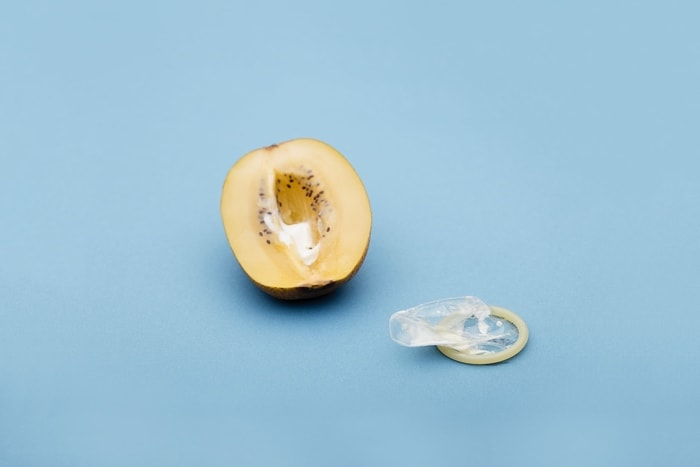- Bacterial vaginosis is the most common bacterial infection in the vagina, affecting between 50–70 percent of women at some point during their reproductive years.
- More than half of women affected by BV will be plagued by it repeatedly.
- Antibiotics can help clear BV infections, but antibiotics alone are not enough. Although antibiotics can kill bad bacteria, they are also capabale of targeting the good ones. The best way to maintain your vaginal bacterial balance is to take probiotics for vaginal health and use thoughtful prevention measures
Have you ever had an ex who just won’t leave you alone? You’re totally over them, yet they think you might get back together? Unfortunately, some infections act the same way as a pesky, lovesick ex. Just when you think you’ve both moved on, an infection like bacterial vaginosis (BV) comes knocking at your door again.
You may not have even heard of BV, but it’s the most common bacterial infection in the vagina, affecting between 50–70 percent of women at some point during their reproductive years. (1) And, unfortunately, it’s particularly difficult to get rid of—around 52 percent of women exhibit recurrent BV at a follow-up visit. (2) That’s right—more than half of women affected by BV will be plagued by it repeatedly.
Some women don’t experience any complaints due to BV, but others may have uncomfortable or embarrassing symptoms. Even if your BV is symptom-free, BV can have long-term implications for reproductive health, so it’s important to seek treatment and prevent it when possible.
If you’ve been impacted by BV, you’d probably like to know what you can do to prevent a recurrence of symptoms. Even if you haven’t had BV, it’s a good idea to know what causes it, so you can prevent it from cropping up in the first place. In this blog, we’ll discuss what BV is, how to recognize its symptoms, and what to do if you’re living with a persistent infection.
What Is Bacterial Vaginosis?
Bacterial vaginosis is a common infection causing inflammation of the vagina (vaginitis). It is caused by a disturbance in the balance of vaginal bacteria. Your vagina naturally contains a balance of bacteria. The different types of bacteria include good and harmful bacteria. When you get BV, you have an overgrowth of bacteria, which causes your uncomfortable symptoms.
Like with other bacterial infections, bacterial overgrowth is treatable with antibiotic treatment. However, BV-causing bacteria can be difficult to eradicate, and depending on your lifestyle and sexual practices, reinfection can occur. Having repeated episodes of BV after your initial treatment is common, and plenty of women experience recurrent BV.
Symptoms of BV
Between 50–75 percent of women with BV experience no symptoms. (3) However, both symptomatic and asymptomatic women are at risk of developing complications from BV including increased HIV risk, pregnancy complications, and preterm birth for pregnant women. Symptomatic women may also experience the following during their bout with BV:
- Abnormal discharge. Women with BV may notice a change in the color of their vaginal discharge. Vaginal discharge in BV may change from clear to slightly grayish or milky white. The discharge may also become thin and watery.
- Abnormal vaginal odor. BV can also cause some women to notice a foul, fishy smell coming from their vagina.
- Change in vaginal pH. The vaginal environment is naturally acidic. An acidic environment helps the vagina fend off harmful bacteria and stay healthy. Normally, the pH of a healthy vagina is less than 4.5; however, in people impacted by BV, the vaginal pH is greater than 4.5.
- Burning and irritation. Burning and irritation, especially when using the bathroom or having sexual intercourse, is a common symptom of BV. However, many vaginal conditions, including vaginal yeast infections and urinary tract infections, can also cause similar symptoms, so it’s important to get tested if you feel discomfort in your genital area.
BV vs. Yeast Infections
Like a yeast infection, BV can cause discomfort and unusual discharge from the vagina. However, yeast infections and BV are different infections, with different causes and treatment. It’s important to recognize the differences between each so that you deal with your infection appropriately. Here are a few key differences so you can determine if your infection is a yeast infection or BV:
- Symptoms: BV can cause a milky, watery discharge in women, while vaginal yeast infections cause a chunky, white vaginal fluid with a cottage cheese-like consistency.
- Causes: Yeast infections are caused by an overgrowth of fungus in your vagina, while BV is caused by an overgrowth of bacteria.
- Treatment: Yeast infections are treatable with over-the-counter medications, while BV requires antibiotic treatment.
Causes of Recurrent BV
Your vagina naturally contains a balance of good and harmful bacteria. This bacterial balance is maintained by your vagina’s pH. The good bacteria is called lactobacillus, and harmful bacteria, or anaerobic bacteria, can be a couple of different types but is typically gardnerella vaginalis, bacteroides or provetella.
Recurrent BV is characterized by multiple episodes of BV within one year. According to some research, most cases of BV are caused by new sexual partners; however, recurrent BV may occur due to monogamous sex with your current partner. (4/5) Women having sex with women are at an increased risk of developing BV because they may transmit vaginal fluid to one other via sex or the use of shared sex toys. If you have a female partner and are struggling with recurrent BV infections, your partner may want to get checked to see if they have BV, even if they have no symptoms.
Is BV a Sexually Transmitted Infection?
Although sexual activity increases your risk of developing BV, plenty of women who are not sexually active develop BV. Lots of risk factors can disrupt your vaginal microbiome, including sexual activity, pregnancy, using birth control pills or an intrauterine device for birth control, and some hygiene practices, like douching. That’s because these situations can change the pH of your vagina and create an environment for harmful bacteria to flourish.
Because BV can be transmitted sexually and non-sexually, it is not technically considered to be a sexuallly transmitted infection.
Is Your Sexual Partner To Blame for Recurrent BV Symptoms?
Research is still ongoing as to how recurrent BV infections occur.6 Some studies are currently investigating whether treatment of men for BV-causing bacteria could help prevent women from developing infections. (7) While men are very unlikely to develop BV themselves, sexual contact with new partners (especially with multiple partners) is the most common cause of BV.
Until more information is gained from further research, it’s unclear if recurrent BV is caused by reinfection from your sexual partner or another reason and if getting your partner treatment can help clear your infection. However, limiting the number of new sexual partners you have intercourse with can help prevent BV infection in the first place.

Diagnosis of Recurrent BV
If you think you have BV, it’s important to get a diagnosis from a health care provider or sexual health clinic, since BV is commonly confused with yeast infections or certain sexually transmitted infections.
Your health care provider will start by taking a thorough medical history from you. Next, they may conduct a pelvic exam in order to check the lining of the vaginal wall and cervix.
If BV is suspected, a laboratory sample of your vaginal discharge will be taken to confirm the presence of BV-associated bacteria in your vagina. Your health care provider will also check your vaginal pH to help detect the infection.
Finally, your health care provider may perform a “whiff test.” To perform this test, they’ll mix some of your vaginal discharge with potassium hydroxide. In women with BV, this combination will produce a very distinct fishy odor.
Treatment of Recurrent BV
Women with symptoms should seek treatment for BV to get relief from their discomfort and prevent further health complications like HIV or pelvic inflammatory disease (PID). The standard treatment for BV is antibiotics. Your health care provider may prescribe a few different antibiotics to help you deal with your BV infection. Some common antibiotics prescribed for symptomatic women are:
- Metronidazole. Metronidazole is available as an oral pill or as a topical vaginal cream or gel which must be inserted into the vagina. Metronidazole can’t be taken if you consume alcohol, so make sure to follow the instructions closely if you’re prescribed this medication.
- Clindamycin. Vaginal clindamycin is usually available as a vaginal cream. It is quite effective in treatment of BV infections.
- Tinidazole. Tinidazole is taken orally as a tablet. Like metronidazole, it can upset your stomach if you take it while consuming some substances, like alcohol. Discuss the side effects of any medication with your doctor prior to starting treatment for BV.
Antibiotics can help clear BV infections, but antibiotics alone are not enough. Although antibiotics can kill bad bacteria, they are not capable of replenishing the good ones. For people wondering how to get rid of BV without antibiotics, take our advice: the best way to maintain your vaginal bacterial balance is to take probiotics for vaginal health and use thoughtful prevention measures, like washing your vagina only with water and avoiding the use of harsh soaps or creams in your vagina.
Prevention of Recurrent BV
BV’s symptoms are annoying, but untreated BV or recurrent infections can increase your risk for serious health problems, like HIV, PID, and pregnancy complications in pregnant women. That’s why it’s really important to prevent recurrent BV infections whenever possible. To prevent BV infections, try the following:
- Regularly wash your vagina with water. Keeping good genital hygiene is the best way to prevent genital infections. However, the vagina is a self-cleaning organ—pretty cool, right? The purpose of your vaginal fluid is to wash bad bacteria and contaminants out of your vagina—no rigorous cleaning methods necessary! However, regularly rinsing with water when you shower can help keep your vagina clean without disrupting your vaginal microbiome. Additionally, make sure you wipe from front to back after using the bathroom. Wiping in the opposite direction (from back to front) can introduce bacteria from your anus into your vagina or urethra, which can cause infections.
- Do not use harsh soaps or perfumed vaginal creams. Your vagina is a very delicate environment, with a precise pH and bacterial balance. Unfortunately, harsh soaps, perfumed creams, or other chemical agents can easily disrupt your vaginal environment and make it susceptible to infection.
- Avoid using douches. Some people think douching is necessary to keep the vagina clean, but doctors actually recommend against regular douching. (8) Douching can accidentally kill good bacteria, disrupt your vaginal pH, and make it difficult to become pregnant. We’ll say it again—your vagina is self cleaning, and no fancy cleansing methods are necessary to keep it healthy.
- Use protection during intercourse. Even though BV is not a sexually transmitted infection, sexual intercourse can introduce new bacteria and disrupt your vaginal pH. For example, semen has a higher pH than the vagina, so having penile-vaginal sex without protection can cause your vaginal pH to increase. If you’re having sex with men, use a condom. If you’re having sex with a female partner, try using a dental dam, and cover sex toys with a condom to prevent spreading bacteria to one another.
- Limit the number of sex partners. While the mechanisms behind recurrent BV infections aren’t entirely clear, having sex with multiple partners increases your risk of developing BV. To help prevent recurrent infections, avoid having sex with multiple different partners.

Liquid Chlorophyll
Our Happy V® Liquid Chlorophyll was formulated with a water-soluble Chlorophyllin that is better absorbed by the body. It works to reduce unwanted body odors, improve digestion and support gut health.
Learn more
Don’t Let Recurrent BV Ruin Your Sex Life—Experience Freedom From BV With Happy V
BV can cause pain or embarrassment while having sex. For natural BV treatment that lets you focus on the fun of sex and increase your sexual wellness, try Happy V’s cranberry pills for BV. Our formula is crafted with Pacran and concentrated cranberry to prevent bad bacteria from sticking around in your vagina. For a proven BV odor remedy, try our liquid chlorophyll drops, which detoxifies and eliminates unwanted odors.

D-Mannose + Cranberry
Our Happy V® D-Mannose + Cranberry was created for anyone who is experiencing symptoms related to Urinary Tract Infections. Eliminate the pain, burning sensation, constant need to urinate and vaginal irritation.
Learn more- https://www.ncbi.nlm.nih.gov/books/NBK459216/
- https://journals.sagepub.com/doi/abs/10.1258/0956462971919444
- https://youngwomenshealth.org/2012/09/21/bacterial-vaginosis/
- https://sti.bmj.com/content/80/1/8#block-system-main
- https://www.livescience.com/36842-vagina-infections-more-likely-to-recur-in-monogamous-couples.html
- https://sti.bmj.com/content/80/1/8
- https://bmcinfectdis.biomedcentral.com/articles/10.1186/s12879-020-05563-w
- https://www.womenshealth.gov/a-z-topics/douching
Check out Our Prebiotic + Probiotic to cover all your women wellness needs!
- A-
- A+
Check out Our Prebiotic + Probiotic to cover all your women wellness needs!





